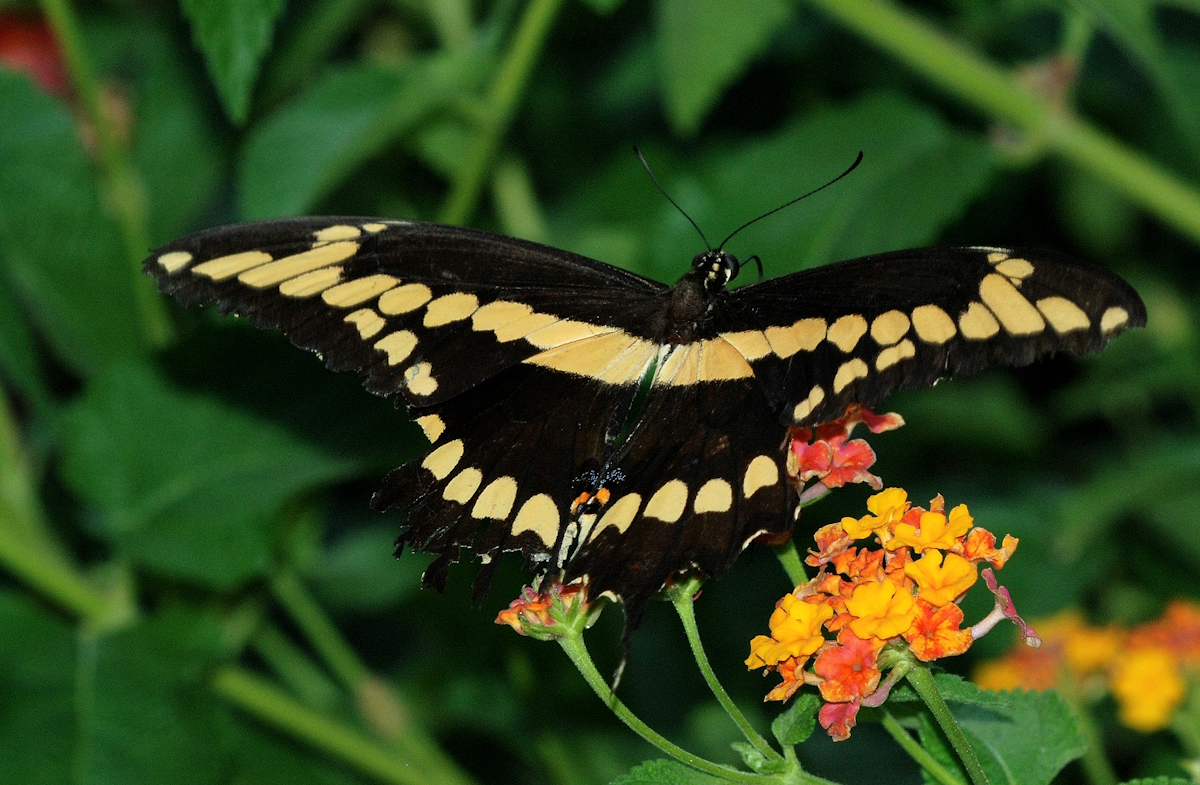
Giant swallowtail (Terry W. Johnson)
By Terry W. Johnson
I have a fascination with the giant swallowtail.
Perhaps this is because its 4.5- to 5.5-inch wingspan earns it the reputation as the largest butterfly in North America. Then again, it may be due to the fact the giant swallowtail is both large and beautiful. From above, its chocolate brown wings are marked with diagonal bands of large yellow spots that extend from its forewings to the base of its abdomen. In addition, the tips of its hindwings are yellow.
While this gorgeous butterfly ranges across Georgia, it is far more common in those counties south of the Fall Line. Little did I know that my fascination with this butterfly would lead me to a plant with a history as odd as the giant swallowtail is pleasing to the eye. The plant I am referring to is common rue (Ruta graveolens).
My efforts to attract the giant swallowtail to my yard have centered on providing a continuous supply of nectar plants throughout as much of the growing season as possible. This has not proved to be a winning strategy. Although the flowers annually attract a wide variety of butterflies, bees and other pollinators, rarely have I seen a giant swallowtail avail itself of the energy-rich food offered by the plants.
Since I began my efforts to attract giant swallowtails, I have planted two wafer ash plants. This nondescript shrub serves as a host plant for the giant swallowtail. Both of the plants are still quite small. I hope that when they get larger, female giant swallowtails with lay their eggs on their foliage.
In the meantime, a Bibb County resident told me the common rue plants growing in her yard annually host numerous giant swallowtail caterpillars. Upon hearing this glowing endorsement, I decided to plant rue in hopes it might be the answer to my problem. However, before I did so I wanted to learn all I could about it. What I discovered was rue has a fascinating history, as well as some vital precautions you’ll want to weigh before planting.
Rue is native to the Balkan Peninsula. Classified by botanists as a subshrub, the plant grows only 2-3 feet tall. In addition to being a host plant for the giant swallowtail, its blue-green foliage and clusters of yellow flowers, which are visited by other pollinators, make it an attractive addition to gardens. The plant is drought-resistant and grows in a wide range of soil types and soil moisture levels. In addition, common rue is deer-resistant.
On the downside, rue is poisonous. Like native plants such as poison ivy, some gardeners break out into a rash when they handle it. To ensure this doesn’t happen to you, wear latex gloves when touching it. Although historically common rue has been used in preparing a number of Chinese and Mediterranean dishes and as a cure for various ailments, you should never do so because the medical community now says the risk of consuming rue outweighs any potential benefits. In addition, never allow children to ingest any portion of the plant.
The history of rue is truly fascinating. Some experts believe the phrase “you will rue the day” stems from the fact that touching the plant can result in discomforting rashes and blisters. Rue is mentioned in the Bible, Shakespeare’s plays and the writings of Milton. Rue was once sprinkled on holy water and was also employed to ward off witches. In addition, during Shakespeare’s time it was considered a sign of joy. In another interesting note, rue was the inspiration for the symbols depicted on the club suit in a deck of cards.
When I decided to conduct a field trial on rue, I quickly learned many nurseries do not stock it. However, much to my surprise, earlier this year I located rue at a local nursery.
I have been closely watching my rue plant in hopes of spotting a giant swallowtail caterpillar or two. To date, no caterpillars have been seen. Checks of my wafer ashes have also failed to locate giant swallow caterpillars there either. A local gardener told me that giant swallowtail caterpillars did not appear on her plants until the year after they were transplanted into her garden.
Some of the lessons I have I learned about gardening for wildlife is that it is a process of trial and error. In your efforts to find what works for you, not every technique or plant will work. Indeed, some of the native and ornamental plants I have tried proved to be unsuitable for my yard here in middle Georgia. As such, wildlife gardeners must have patience. Consequently, before I rue the fact that I planted rue in my yard, I will give it more than one season to attract a giant swallowtail.
Terry W. Johnson is a retired DNR program manager and executive director of TERN, the Wildlife Conservation Section’s friends group. Check out past columns, his Backyard Wildlife Connection blog and his book “A Journey of Discovery: Monroe County Outdoors.” Permission is required to reprint his columns.




















